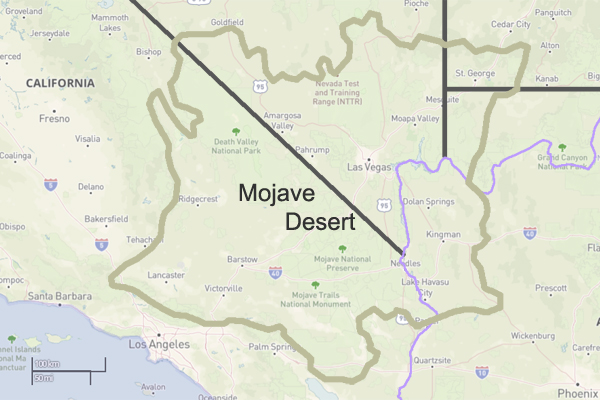/geography/
The Mojave Desert is a vast desert in the southwestern United States, primarily in southeastern California, southern Nevada, and parts of Arizona and Utah.

Here are some key geographical features and characteristics of the Mojave Desert:
- Location:
- States: Primarily in California and Nevada, with smaller portions in Arizona and Utah.
- Extent: The Mojave Desert is part of the larger North American Desert and is the smallest of the four major deserts in the United States.
- Size:
- The Mojave Desert covers approximately 47,877 square miles (124,000 square kilometers).
- Topography:
- The desert’s topography is varied, featuring flat basins, rugged mountains, and expansive valleys.
- Some prominent mountain ranges include the Providence, New York, and Clark Mountains.
- Landforms:
- Playas: Dry lake beds or playas are scattered throughout the desert.
- Mesas and Buttes: Flat-topped plateaus and isolated hills dot the landscape.
- Dunes: The Kelso Dunes and Eureka Dunes are extensive dune fields in the Mojave.
- Climate:
- The Mojave Desert has a typical cold desert climate with hot summers and mild winters.
- Summer temperatures can exceed 100°F (38°C), while winter temperatures can drop below freezing, especially at higher elevations.
- Rainfall is generally low, and the desert experiences occasional flash floods during intense rainstorms.
- Vegetation:
- The desert is home to various plant species adapted to arid conditions, including Joshua trees, creosote bushes, yuccas, and cacti.
- Higher elevations may support juniper and pinyon pine forests.
- Wildlife:
- Desert wildlife, including desert tortoises, bighorn sheep, kit foxes, and various reptiles, is adapted to harsh conditions.
- Bird species such as roadrunners, eagles, and vultures are also common.
- Human Impact:
- Human activities in the Mojave Desert include mining, military training areas, and recreational activities.
- Cities such as Las Vegas, Nevada, and Lancaster, California, are located on the periphery of the Mojave Desert.
- National Parks and Protected Areas:
- The Mojave National Preserve, Joshua Tree National Park, and portions of Death Valley National Park are located within the Mojave Desert, protecting its unique ecosystems and landscapes.
Understanding the geography of the Mojave Desert involves recognizing its diverse terrain, climate, and the various plant and animal species that have adapted to this challenging environment.